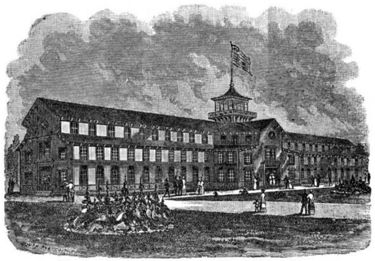1884 Alabama State Exposition
The 1884 Alabama State Exposition was an exhibition of Alabama's resources, farm products, manufacturing, and military capabilities which was held in the newly-expanded Alabama Mineral Exposition Building in Birmingham's Capitol Park during the summer of 1884. It was managed jointly by the Birmingham Board of Trade and the City of Birmingham.
The exhibition opened on April 22, 1884. Governor Edward O'Neal, Mayor A. O. Lane, and other dignitaries were escorted to the site by the newly-uniformed Birmingham Police Department, three fire companies, and several companies of the Alabama State Militia. The train carrying the Warrior Guards was delayed for nearly two hours.
After a prayer led by Reverend L. S. Handley, the first address was given by Board of Trade president James Van Hoose, followed by Mayor Lane. The speakers acknowledged that the exhibit, at the time of opening, was somewhat modest, but expected it to be expanded and enhanced over time. Lane used his speech to praise the efforts of Southerners to build up the state's industries, and to correct the "prevalent error" that Northern capital and expertise predominated in developing the district. Governor O'Neal mentioned that the Birmingham exhibition would set a precedent for, "a system of expositions for the whole state." After the dedicatory speeches, the doors of the exposition building were opened to the crowd. Grambs' Orchestra performed during the event. The fire companies put on a demonstration at the corner of 20th Street and 2nd Avenue North, spraying water above the roof of the nearby National Bank building.
The evening of the exposition's opening was marked by a military ball at Esmeralda Hall.
Exhibits
|
|
References
- "Exposition Opened" (April 24, 1884) The Iron Age, p. 3
